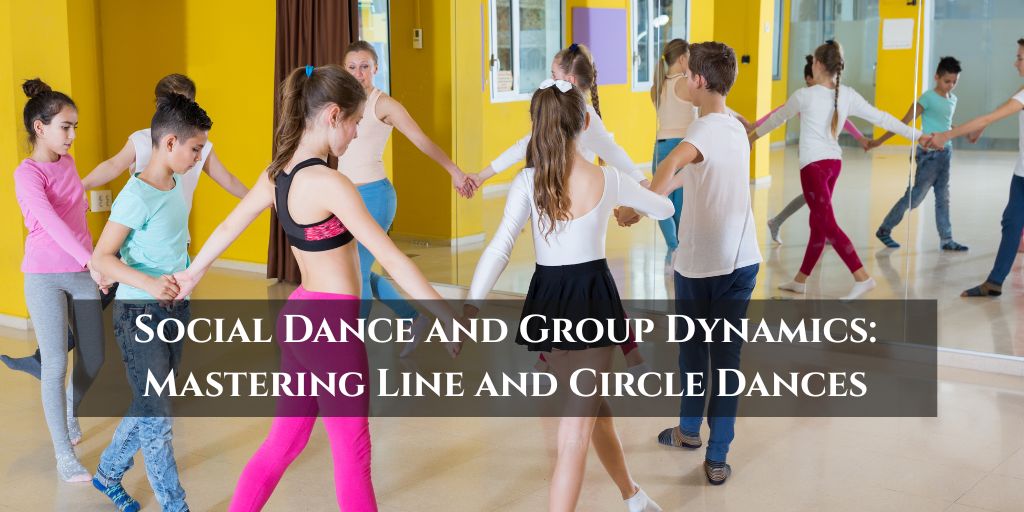Isn’t it amazing how a simple dance move can turn strangers into friends in minutes? Group dance formats like line and circle dances transform individual steps into a collective story.
You don’t just learn moves, you learn how to connect, react, and sync with everyone around you. It’s all part of what makes the scene so vibrant in social dance Singapore.
Let’s step into the group dynamics of social dancing and discover how mastering line and circle dances can elevate your dance journey.
What Are Line and Circle Dances?
Let’s start with the basics.
Line dancing involves individuals arranged in rows, all performing the same choreographed steps at the same time. There’s no physical contact involved, but the synchronisation makes everyone feel connected.
Circle dances, on the other hand, involve dancers holding hands or placing hands on shoulders, forming a circle while moving in patterns, often around a central point. This is common in folk traditions and increasingly popular in community dance events and group dance classes across Singapore.
These dance formats may seem simple, but they carry deep social and psychological benefits that go far beyond the dance floor.
The Power of Group Dynamics in Dance
Group dynamics are the invisible threads that hold a social dance session together. Here’s why they matter:
-
Coordination: Line and circle dances demand synchronised movement. You’re constantly reacting to and mirroring others, sharpening your timing and body awareness.
-
Connection: Circle dances build non-verbal communication as dancers take cues from each other, smiles, eye contact, or subtle gestures.
-
Community Building: Repeated group formations forge social bonds, making these styles perfect for newcomers who might feel shy entering the dance scene.
In social dance events, this collective energy is what makes the experience more than just exercise; it’s a social glue.
Line Dance: Getting in Sync with the Group
Example: West Coast Swing Line Variations
Though West Coast Swing is traditionally a partner dance, line formations, especially during jam sessions, are popular.
Dancers perform stylised routines, such as “Swustle” line dances, focusing on musicality and timing while maintaining individuality within a collective.
In this setting:
-
Footwork accuracy matters more than tricks.
-
You learn to match groove and attitude with those sharing the dance floor.
-
Mistakes are part of the fun; everyone resets and flows back in.
This makes line dancing perfect for building group confidence and learning rhythm without needing a partner.
https://www.instagram.com/p/DF7tnxjyDc_/?hl=en
Circle Dance: Dynamic, Playful, and Social
Example: Salsa Rueda
Rueda de Casino, a Cuban-style salsa danced in a circle, is the embodiment of fast-paced group dynamics. One leader calls out moves, and dancers quickly adapt, rotating partners with flair.
You’ll experience:
-
Instant feedback, if you miss a cue, you’ll know quickly!
-
Rapid adaptation, improving your improvisation, and attentiveness.
-
Enhanced social fluidity, as you engage with multiple partners in one song.
Singapore’s Latin socials often include Rueda segments, especially in community-based events, giving you a taste of communal joy and quick-footed spontaneity.
Bachata: Line and Circle Fusion Possibilities
Bachata, known for its sensual partner work, also adapts beautifully to line and circle structures during warm-ups and socials.
-
In line formations, you may see group choreographies that emphasise body rolls, hip movements, and foot taps, all in sync with a group.
-
In circle Bachata, some events experiment with rotating partners mid-song, building social variety.
For those new to social dance scenes, these group formats are gentle entry points to a style known for its intimacy, without the pressure of close partner work right away.
Why Group Dance Formats Matter in Singapore’s Social Scene
Singapore’s multiculturalism and vibrant music scene make it a fertile ground for community-centric dancing.
Dance studios and socials alike often use line and circle dances for:
-
Workshops: Where beginners can practice without needing a partner.
-
Icebreakers: Especially at large events or themed socials.
-
Performance practices: To teach show routines or festival group numbers.
In spaces like social dance Singapore meetups, these formats are the backbone of building a welcoming and interactive environment.
Tips to Master Line and Circle Dances
-
Watch before you jump in: Observe rhythm and cues first, especially in unfamiliar formats.
-
Stay light on your feet: Quick adjustments keep the group flow smooth.
-
Listen actively: Most sequences are musically driven, learn the beats and accents.
-
Smile and enjoy: Group dances are more about energy than perfection.
Final Thoughts
Be it stepping in line with a West Coast Swing group or twirling through a Salsa Rueda circle, group dances invite you to be part of something bigger than yourself.
So, if you’re ready to dive into the social dance scene, don’t just wait for a partner, join the line, step into the circle, and move with the crowd.
Looking for where to begin? Join classes and socials at ZiggyFeet, one of the most welcoming homes for social dance lovers in Singapore.
So lace up, show up, and step into a new kind of connection.
Note: The content on this article is for informational purposes only and does not constitute professional advice. We are not responsible for any actions taken based on the information provided here.

